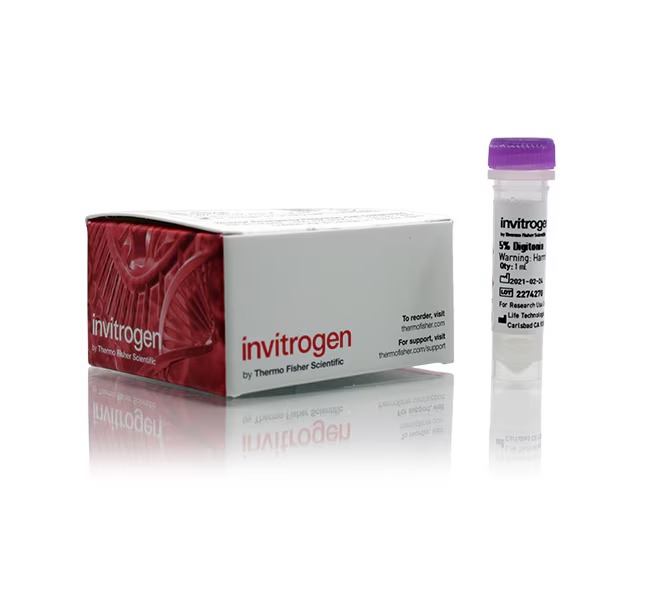Specifications:
| Application | Gel Electrophoresis | ||
| Storage Temperature | 2-8°C | ||
| Product Type | Buffer | Forms | Liquid |
| Product Brand | Thermo Fisher Scientific™ | ||
| Product Grade | Molecular Biology | ||
Invitrogen™ Digitonin (5%) Solution is a mild, non-ionic detergent with a cholesterol-like structure that facilitates the solubilization of lipids and membrane-bound proteins. Digitonin is widely used in native protein extraction, membrane protein solubilization, immunohistochemistry (IHC), cryo-electron microscopy (Cryo-EM), and crystallography.
This ready-to-use 5% digitonin solution is an essential reagent for cell permeabilization, antibody penetration in tissue sections, and sample preparation for NativePAGE electrophoresis. It enhances the resolution of hydrophobic and membrane proteins in native gel electrophoresis and can be used as a cytotoxicity chemistry positive control.
Key Features & Benefits
- Mild, Non-Ionic Detergent for Protein & Lipid Studies
- Facilitates membrane protein solubilization while preserving their native lipid environment.
- Compatible with cryo-EM, crystallography, and detergent-based extraction workflows.
- Essential for Native Gel Electrophoresis & Protein Analysis
- Included in the NativePAGE Sample Prep Kit (BN2008) to improve solubility of hydrophobic proteins.
- Compatible with NativePAGE Novex Bis-Tris Gels, improving protein resolution and reducing streaking.
- Optimized for Cell Permeabilization & Immunohistochemistry (IHC)
- Enhances antibody penetration into tissue sections for fluorescence and histological staining.
- Used at 0.2–0.5% in buffer for IHC compatibility.
- Supports Cryo-EM & Structural Determination Studies
- Used at 1–2% (w/v) for membrane protein solubilization before structural analysis.
- Helps with protein particle distribution and grid vitrification.
- Ready-to-Use, 5% Liquid Solution
- Provides high purity and convenience for research applications.
- If precipitated, warming at 37°C with gentle shaking restores solubility.
Product Specifications
| Feature | Details |
|---|---|
| Product Name | Invitrogen™ Digitonin (5%) Solution |
| Catalog Number | BN2006 |
| CAS Number | 11024-24-1 |
| Concentration | 5% |
| Molecular Weight | 1229 g/mol |
| Detection Methods | Immunohistochemistry (IHC), Cryo-EM, Crystallography |
| Formulation | Liquid |
| Volume | 1 mL |
| Storage Conditions | 2–8°C |
| Shipping Conditions | Wet Ice |
| Gel Type | Native-PAGE |
| Reagent Type | Non-Ionic Detergent |
| For Use With | Mini Gel Tank, XCell SureLock Mini-Cell |
| Compatible With | NativePAGE Gels |
| Application Areas | Native Gel Electrophoresis, Membrane Protein Solubilization, Structural Biology |
Use Cases & Applications
1. Membrane Protein Solubilization & Structural Biology
- Preserves Native Lipid Environment in Membrane Proteins
- Extracts membrane proteins while maintaining their activity.
- Used at 1–2% (w/v) for structural studies like Cryo-EM & X-ray crystallography.
- Enhances Protein Stability for Cryo-EM Grid Preparation
- Helps with particle distribution and preferred orientation in vitrification.
- Optimizes sample quality for high-resolution structural determination.
2. Cell Permeabilization & Immunohistochemistry (IHC)
- Facilitates Antibody Penetration in Fixed Tissue Sections
- Ensures efficient labeling of intracellular targets.
- Recommended at 0.2–0.5% concentration for IHC applications.
- Used as a Cytotoxicity Positive Control in Cell Studies
- Permeabilizes cell membranes for controlled cell death assays.
- Helps study apoptosis and cell permeability pathways.
3. NativePAGE Electrophoresis & Protein Sample Preparation
- Enhances Solubility of Hydrophobic & Membrane Proteins
- Included in NativePAGE Sample Prep Kit (BN2008).
- Compatible with 10% DDM, 5% digitonin, and NativePAGE Novex Bis-Tris Gels.
- Improves Protein Resolution & Reduces Streaking in Gels
- Maintains protein integrity during native gel electrophoresis.
- Helps increased resolution of membrane-bound protein complexes.
4. Detergent-Based Extraction & Biochemical Assays
- Compatible with Lipid Raft Studies & Cholesterol Research
- Solubilizes lipid rafts while maintaining their native composition.
- Used for biochemical analysis of cholesterol-binding proteins.
- Works as a Mild Detergent for Protein Purification Protocols
- Prevents protein aggregation in biochemical studies.
- Ideal for chromatography-based membrane protein purification.
Instructions for Use
Protein Extraction & Sample Preparation:
- Solubilization of Membrane Proteins:
- Dilute 5% digitonin solution to 1–2% (w/v) in the desired buffer.
- Incubate with membrane protein samples for 30–60 min at 4°C.
- Centrifuge at 100,000 x g for 1 hour and collect the supernatant.
- Cryo-EM & Crystallography:
- Prepare a digitonin-containing wash buffer for particle stabilization.
- Use at CMC concentration to improve grid vitrification and orientation.
- Immunohistochemistry (IHC):
- Permeabilize cells using 0.2–0.5% digitonin in PBS.
- Incubate with primary antibodies and proceed with standard IHC protocols.
- NativePAGE Electrophoresis Sample Prep:
- Mix digitonin with protein lysates for sample preparation.
- Load prepared samples onto NativePAGE Novex Bis-Tris Gels for analysis.
Storage & Handling Instructions
- Storage Conditions:
- Store at 2–8°C.
- If precipitate forms, warm to 37°C and shake gently to redissolve.
- Handling Precautions:
- Use aseptic techniques to avoid contamination.
- Prepare fresh working solutions for optimal performance.
- Disposal Guidelines:
- Dispose of digitonin-containing solutions following institutional chemical waste regulations.
Why Choose Invitrogen™ Digitonin (5%) Solution?
✅ Mild, non-ionic detergent for lipid & membrane protein solubilization
✅ Optimized for structural biology, Cryo-EM, and crystallography
✅ Enhances hydrophobic protein solubility for NativePAGE Electrophoresis
✅ Facilitates antibody penetration in IHC & cell permeability studies
✅ Ready-to-use 5% solution for convenient laboratory applications
Invitrogen™ Digitonin (5%) Solution is a versatile detergent for biochemical research, providing superior membrane protein solubilization, sample preparation for electrophoresis, and cell permeability studies.




 0
0
